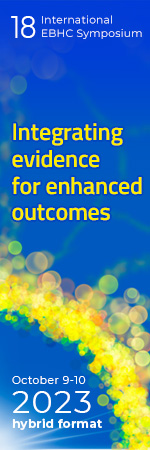 |
||
 
| ||
|
Activity
|
3rd International EBHC Symposium 2008
“Rational behind the reforms”  Download EBHC Symposium 2008 Final Programme (770 kB) Download EBHC Symposium 2008 Final Programme (770 kB)Editions: 2006 | 2007 | 2008 | 2009 | 2010 | 2011 | 2012 | 2013 | 2014 | 2015 |
The Symposium took place in Krakow of November 24-25 2008 from the initiative of:
In the last year we had the pleasure of organization of the 2nd EBHC Symposium, which resulted in sharing of experience, establishing of new relations and further cooperation between scientists in Poland and worldwide. Our invitation was then accepted by nearly 300 specialists in HTA and decision-makers as well as scientists from Europe and the USA.
The leading theme of this year’s EBHC Symposium was comparison of experience and discussion concerning development of the reform of health care systems in countries of Central and Eastern Europe and their analysis with respect to rationality and accordance with principles of EBHC. Invitations to deliver lectures had been accepted by many worldwide recognized experts, among them a few pioneers of Evidence-Based Health Care. Among participants of the EBHC Symposium representatives of public institutions (including the Ministry of Health, the National Health Fund, the Parliament, the Office of the President of the RP and local government) as well as those of the world of medicine, politics and business were present, including potential investors on health insurance market in our country. On behalf of all the persons and institutions engaged in organization of the Symposium we heartily thank you for taking part in this event, so important for Polish medical environment. Schedule
Speakers
Sessions
1. Discussion panel: Planned changes. Is the reform in Poland leading to EBHC?
The objective of this panel is to present intended reforms in the Polish health care system. The key issue will be reflection on rationality of the reforms, which will be analyzed with respect to EBHC theory and practice. Representatives of the payer and the legislator as well as experts in health care management will take part in the discussion. Key issues for planned reforms, important for efficient function of the Polish health care system, will be discussed. The following subjects are proposed:
2. Economic implications of equal access to health care
Access to health care and quality of health care services are among the key issues of the state health policy. Any limitations in access to health care services (e.g. queue system) may have direct effects on the state of health of the society. Delays in diagnosis and treatment usually significantly decrease the chance of successful treatment and thus have a negative effect on the patients’ quality of life.
The session will focus on the issue of access to health care services depending on the solutions applied. The problems will be presented by recognized experts representing both government and independent institutions in Poland and worldwide (e.g. representatives of the World Bank). The speakers will present different models of the health care system, methods of resource allocation to health care services and effects of different solutions on accessibility of health care services. 3. CE thresholds and rewarding of the innovation
Cost-effectiveness and cost-utility thresholds have been discussed for years all over the world. In developed countries annual cost of dialysis used to be regarded as a widely accepted threshold value for the cost of one life year gained (LYG). Recently the WHO, the NICE and numerous payers presented their opinions concerning use of such cost-utility measures as DALY and QALY in assessment of health technologies financed from public means. The opinion of the British National Institute for Clinical Excellence seems to be one of the most comprehensive, taking into account estimation of willingness to reimburse a technology depending on the degree of uncertainty as to its cost-effectiveness or cost-utility in a specific indication. This has implications not only for reimbursement decisions, i.e. placing of various technologies in a basic benefit package (in a wide sense), but also for development of analysis methodology in health technology assessment as well as willingness to pay for innovation and progress in medicine.
Tendency to “reward” innovative health technologies of a specific kind varies between countries. After cost-effectiveness or cost-utility ratio for a technology has been evaluated, other aspects are assessed, innovation being one of the most important. This leads to various questions:
4. International cooperation in the pursue for EBHC
During this session innovative programs, financed from international sources, will be presented.
The first program was conducted by the Ministry of Health of the Republic of Serbia and financed by the World Bank credit. Before an institution for health technology assessment was established, the Ministry decided to perform a feasibility study for system implementation of HTA, based on international experience in this matter. The project consisted of two separate but strongly connected parts. The first part concerned choice of the most suitable (in Serbian circumstances) model of function of an HTA agency. Design of the model was based on experience of similar institutions functioning in the whole world. Results of that analysis allowed for a rational decision concerning the form and function of the Agency, based on practical data. The other part of the project concerned the basic benefit package. Parts of the package already existing in Serbia were described, along with the procedures and criteria for inclusion and exclusion of health technologies. In the next stage possible solutions, tested in other countries, for specific parts of the package were presented. The choice of specific solutions is aimed at introduction of a system with a benefit package functioning according to the EBHC principles. Both parts of the project allow for improvement of the existing basic benefit package in Serbia and the choice of a model of function for the HTA agency in Serbia, adjusted to current possibilities and system solutions. In the second part of the session Dr. Ad R. Schuurman, the Chair of MEDEV, will present the principles and results of cooperation between public payers in EU. The main objective of the MEDEV activities (established in 1998) is coordination of activities and exchange of experience concerning medicines policy in the EU member countries. The MEDEV activities include preparation of directives concerning methodology of use of HTA in reimbursement decision making, comparison of national packages of medicines and promotion of transparent, evidence-based principles policy making. 5. Rebates and risk sharing agreements between payers and pharmaceutical industry
Modern tools in “financial engineering” concerning health care services, financed from public means in Poland, still not present in legal acts. Changes in this area should include allowance of risk sharing agreements between the Ministry or the payers and pharmaceutical industry, conditional reimbursement (e.g. coverage with evidence development – CED) and perhaps price-volume agreements or payback (in a modified form). Although centralized purchasing could be organized at present, it is not used in practice due to formal requirements being troublesome and difficult to fulfill. It is therefore important to remove barriers, introduce new legal possibilities and encourage the Ministry and the payers to begin a real active pricing policy.
During the session various tools will be presented and advantages of different arrangements as well as concerns or threats associated will be discussed. 6. Improving pharmacovigilance in UE
Despite awareness of hazards associated with use of any pharmacotherapy, medical personnel remains reluctant to report adverse events associated with use of medicines. The Office for Registration of Medicinal Products estimates that only 10% of the physicians take part in the reporting. Both the Office and pharmaceutical industry agree that expenditure on human resources in pharmacovigilance is still low.
Lessons from history and cases of apparently innovative drugs being withdrawn from the market (vide rofecoxib) forced the decision makers (the EMEA and other institutions involved in registration of medicines) to discuss effectiveness of the present system of pharmacovigilance. The European Commission has developed and is planning to introduce numerous legislative changes presented in a document titled „Strategy to better protect public health by strengthening and rationalising EU Pharmacovigilance” (December 15th, 2007). A Pharmacovigilance Committee will be established (instead of the Pharmacovigilance Working Party) and its decisions will be legally binding for the CHMP Committee. A document titled “Good Vigilance Practice” will contain principles and duties related to good practice for all interested parties in the system of pharmacovigilance. It has been proposed to simplify methods of notification of appropriate authorities (for single cases as well as periodic reports) and a model document “Pharmacovigilance System Master File” has been developed; this would be made available on demand and analyzed during system control in pharmaceutical companies. However, there are two most important changes concerning: All these changes at the European Union level are aimed not only at strengthening of the control system, but also at improvement of quality of data received through improved methodology and higher awareness of the problem of pharmacovigilance. 7. EMB/HTA in the ISO system
In this session ability to exploit opportunities associated with the ISO certification system in EBM/HTA practice will be discussed. The ISO system, being systematic and comprehensive in its solutions, seems to be an attractive method of categorization of certain problems and issues related to practical application of EBM/HTA principles. Education and training in EBM/HTA seems to be a good example. At present the matter is regulated arbitrarily and therefore it is difficult to decide whether a pharmacoeconomist is “properly” or “adequately” educated, since there are no standards concerning methodology and didactics in this area. Issues of education are strictly associated with harmonization of EBM/HTA terminology, which, in some areas, remains not unified. Translation of terms and concepts from English to Polish entails additional problems.
The aim of this session is to present plans of systematization of educational process and classification of terminology for this purpose through application of the ISO certification system in the area of EBM/HTA. The session will be chaired by the President of the TÜV Nord Polska company, who – with assistance of the invited guests – will present plans for implementation of the ISO certification system in EBM/HTA. Download
CEESTAHC Society prints:
|
|
| © Ceestahc.org Wykonała: Agencja A.R.T. Wyświetleń:9012, Data modyfikacji:2016-09-08 | ||



